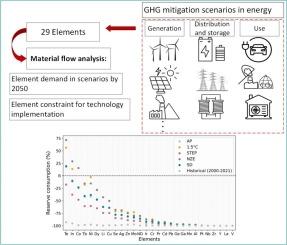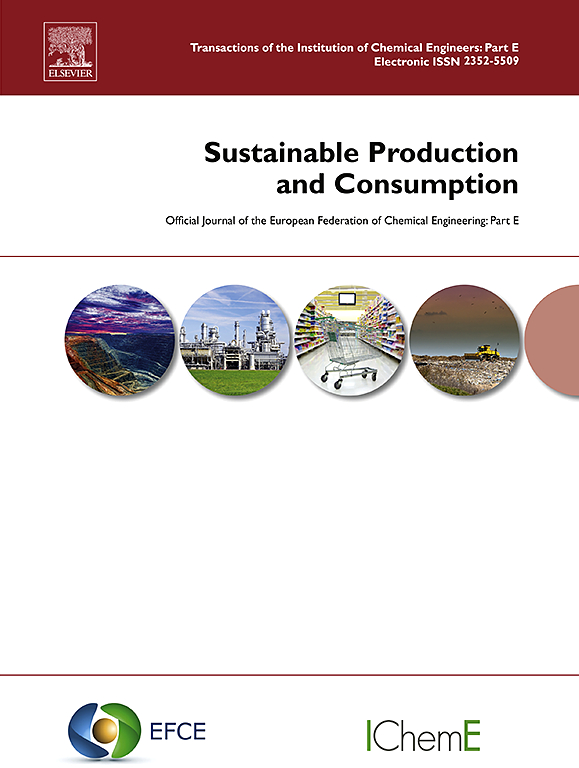减少温室气体(GHG)排放,与全球能源转型保持一致:要素使用情景
IF 10.9
1区 环境科学与生态学
Q1 ENVIRONMENTAL STUDIES
引用次数: 0
摘要
一些旨在减少温室气体排放的拟议技术(如可再生能源和碳捕集与封存 (CCS))面临着重大挑战,如获取关键原材料。本研究评估了各种技术对 29 种矿物元素的需求。研究采用动态材料流分析模型,对 2050 年前的五种全球气候变化减缓情景进行了研究。所选情景为净零排放(NZE)、1.5 °C、2022 年的宣布承诺(AP)和既定政策(STEP),以及 2021 年的可持续发展(SD)。结果表明,从 2022 年到 2050 年,在 "宣布承诺"、"声明政策"、"可持续发展 "和 "1.5 ℃"情景下,对碲的需求将增加并累计超过现有储量;在 "宣布承诺 "和 "声明政策 "情景下,对铟和钴的需求将超过储量。在 STEP 情景中,元素不会短缺。研究结果表明,特定技术的选择,如薄膜太阳能光伏技术的大量使用,会对碲等特定元素的需求产生重大影响。结果表明,温室气体减排技术和方案的选择会对元素的消耗产生重大影响。这项工作的新颖之处在于,它采用了供应效率方法来计算不同能源部门对技术的元素需求,包括最近每种情景下的能源生产、分配、储存和消费部门。本研究提出的结果有助于决策者选择减缓气候变化的技术解决方案。本文章由计算机程序翻译,如有差异,请以英文原文为准。

Mitigation of greenhouse gas (GHG) emissions aligned with global energy transition: Scenarios of elements use
Several proposed technologies (e.g., renewables and carbon capture and storage (CCS)) to reduce GHG emissions face significant challenges like accessing critical raw materials. This study assesses the demand for 29 mineral elements in technologies. A dynamic material flow analysis model was applied to examine five global climate change mitigation scenarios to 2050. The scenarios selected are the Net Zero Emission (NZE), 1.5 °C, Announced Pledges (AP) and Stated Policy (STEP) for the year 2022, and the Sustainable Development (SD) for the year 2021. The results show that demand for tellurium will increase and cumulatively exceed current reserves in the AP, SD, NZE and 1.5 °C scenarios from 2022 to 2050, and demand for indium and cobalt will exceed reserves in NZE and 1.5 °C scenarios. In the STEP scenario, elements will not face shortages. The findings indicate that specific technology choices, such as the high use of thin-film solar photovoltaic (PV), can significantly impact demand for particular elements like tellurium. The results demonstrate that the selection of the technology and scenario for GHG mitigation considerably impacts element consumption. The novelty of this work consists of its supply-efficient approach to the element demand for technology in different energy sectors including in the energy generation, distribution, storage, and consumption sectors in each recent scenario. The results presented in this study could assist policymakers in the selection of technological solutions for climate change mitigation.
求助全文
通过发布文献求助,成功后即可免费获取论文全文。
去求助
来源期刊

Sustainable Production and Consumption
Environmental Science-Environmental Engineering
CiteScore
17.40
自引率
7.40%
发文量
389
审稿时长
13 days
期刊介绍:
Sustainable production and consumption refers to the production and utilization of goods and services in a way that benefits society, is economically viable, and has minimal environmental impact throughout its entire lifespan. Our journal is dedicated to publishing top-notch interdisciplinary research and practical studies in this emerging field. We take a distinctive approach by examining the interplay between technology, consumption patterns, and policy to identify sustainable solutions for both production and consumption systems.
 求助内容:
求助内容: 应助结果提醒方式:
应助结果提醒方式:


